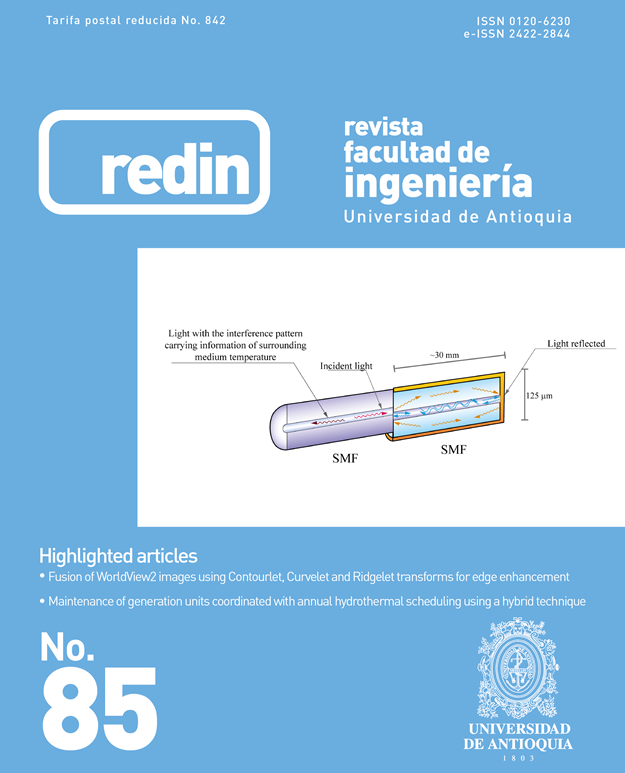Análisis del flujo de carga de series de tiempo integrado para un sistema de distribución práctico en un modelo eólico
DOI:
https://doi.org/10.17533/udea.redin.n85a04Palabras clave:
red de distribución, análisis de flujo de carga, recursos de energía distribuidaResumen
El viento es una fuente limpia de energía, que es naturalmente disponible y ha estado reemplazando las centrales de energía eléctrica convencionales no perennes tales como trmicas, hidroelectricas,nucleares etc., La innovación en el diseño ha reducido gradualmente el costo de instalar una planta de energía eólica, aumentando la penetración de este tipo de energía en la Red de Distribución (DN)de energía. Al ser una generación de energía estacional, la integración de la energía eólica en la red de distribución ha creado muchos desafíos como la estabilidad del voltaje, la confiabilidad del sistema y la estabilidad de la red del sistema eléctrico. Por lo tanto, un análisis exhaustivo de la integración de la energía eólica es necesario para hacer el sistema de energía más estable. Este artículo describe el comportamiento dinámico del sistema de distribución al tiempo que integra la energía eólica mediante análisis de series de tiempo. El flujo de carga se realiza utilizando el método de Newton-Raphson, con un perfil de carga variable. Se realiza un análisis de series temporales que da las características de rendimiento del sistema que se valida en un alimentador de prueba IEEE 123 práctico.
Descargas
Citas
R. Billinton and H. Chen, “Assessment of risk-based capacity benefit factors associated with wind energy conversion systems,” IEEE Transactions on Power Systems, vol. 13, no. 3, pp. 1191–1196, 1998.
I. Cadirei and M. Ermiş, “Performance evaluation of a wind driven doig using a hybrid model,” IEEE Transactions on Energy Conversion, vol. 13, no. 2, pp. 148–155, 1998.
A. E. Feijoo and J. Cidras, “Modeling of wind farms in the load flow analysis,” IEEE transactions on power systems, vol. 15, no. 1, pp. 110–115, 2000.
V. M. Quezada, J. R. Abbad, and T. G. S. Román, “Assessment of energy distribution losses for increasing penetration of distributed generation,” IEEE Transactions on Power Systems, vol. 21, no. 2, p. 533, 2006.
L. F. Ochoa and G. P. Harrison, “Minimizing energy losses: Optimal accommodation and smart operation of renewable distributed generation,” IEEE Transactions on Power Systems, vol. 26, no. 1, pp. 198–205, 2011.
L. de Magalhães Carvalho, M. A. d. Rosa, A. M. L. d. Silva, and V. Miranda, “Probabilistic analysis for maximizing the grid integration of wind power generation,” IEEE Transactions on Power Systems, vol. 27, no. 4, pp. 2323–2331, 2012.
C. Opathella, B. N. Singh, D. Cheng, and B. Venkatesh, “Intelligent wind generator models for power flow studies in pss® e and pss® sincal,” IEEE Transactions on Power Systems, vol. 28, no. 2, pp. 1149–1159, 2013.
J. B. Cardell and C. L. Anderson, “A flexible dispatch margin for wind integration,” IEEE Transactions on Power Systems, vol. 30, no. 3, pp. 1501–1510, 2015.
C.-L. Nguyen and H.-H. Lee, “Effective power dispatch capability decision method for a wind-battery hybrid power system,” IET Generation, Transmission & Distribution, vol. 10, no. 3, pp. 661–668, 2016.
J. W. Choi, S. Y. Heo, and M. K. Kim, “Hybrid operation strategy of wind energy storage system for power grid frequency regulation,” IET Generation, Transmission & Distribution, vol. 10, no. 3, pp. 736–749, 2016.
H. Zhao, Q. Wu, Q. Guo, H. Sun, and Y. Xue, “Optimal active power control of a wind farm equipped with energy storage system based on distributed model predictive control,” IET Generation, Transmission & Distribution, vol. 10, no. 3, pp. 669–677, 2016.
V. M. Da Costa, N. Martins, and J. R. L. Pereira, “Developments in the newton raphson power flow formulation based on current injections,” IEEE Transactions on Power Systems, vol. 14, no. 4, pp. 1320–1326, 1999.
C. Fuerte-Esquivel, E. Acha, and H. Ambriz-Perez, “A comprehensive newton-raphson upfc model for the quadratic power flow solution of practical power networks,” IEEE Transactions on Power Systems, vol. 15, no. 1, pp. 102–109, 2000.
F. Milano, “Continuous newton’s method for power flow analysis,” IEEE Transactions on Power Systems, vol. 24, no. 1, pp. 50–57, 2009.
F. Mumtaz, M. Syed, M. Al Hosani, and H. Zeineldin, “A novel approach to solve power flow for islanded microgrids using modified newton raphson with droop control of dg,” IEEE Transactions on Sustainable Energy, vol. 7, no. 2, pp. 493–503, 2016.
A. Petersson, Analysis, modeling and control of doubly-fed induction generators for wind turbines. Chalmers University of Technology, 2005.
D. Aliprantis, S. Papathanassiou, M. Papadopoulos, and A. Kladas, “Modeling and control of a variable-speed wind turbine equipped with permanent magnet synchronous generator,” in Proc. of ICEM, vol. 3, 2000, pp. 558–562.
D. T. Feeders, “IEEE PES distribution system analysis subcommittee,” Available online: http://www.ewh.ieee.org/soc/pes/dsacom/testfeeders/index.html, 2011.
Descargas
Publicado
Cómo citar
Número
Sección
Licencia
Derechos de autor 2018 Revista Facultad de Ingeniería Universidad de Antioquia

Esta obra está bajo una licencia internacional Creative Commons Atribución-NoComercial-CompartirIgual 4.0.
Los artículos disponibles en la Revista Facultad de Ingeniería, Universidad de Antioquia están bajo la licencia Creative Commons Attribution BY-NC-SA 4.0.
Eres libre de:
Compartir — copiar y redistribuir el material en cualquier medio o formato
Adaptar : remezclar, transformar y construir sobre el material.
Bajo los siguientes términos:
Reconocimiento : debe otorgar el crédito correspondiente , proporcionar un enlace a la licencia e indicar si se realizaron cambios . Puede hacerlo de cualquier manera razonable, pero no de ninguna manera que sugiera que el licenciante lo respalda a usted o su uso.
No comercial : no puede utilizar el material con fines comerciales .
Compartir igual : si remezcla, transforma o construye a partir del material, debe distribuir sus contribuciones bajo la misma licencia que el original.
El material publicado por la revista puede ser distribuido, copiado y exhibido por terceros si se dan los respectivos créditos a la revista, sin ningún costo. No se puede obtener ningún beneficio comercial y las obras derivadas tienen que estar bajo los mismos términos de licencia que el trabajo original.










 Twitter
Twitter